Study on the Energy Saving Potential for Semi-Transparent PV Window in Southwest China
Abstract
:1. Introduction
2. Investigation Methods
2.1. Parameters of PV Module
2.2. Test Methods
2.3. Building Model
3. Experimental Results and Analysis
3.1. Air-Conditioning Electricity Consumption Test
3.2. Lighting Electricity Consumption Test
3.3. Energy Saving Potential Analysis
4. Simulation Analysis of Energy Saving Potential in Typical Cities in Southwest China
5. Conclusions
- The experimental tests of the energy consumption and generation of STPV windows in summer were carried out in two caparison units, and interactional influence amongst air conditioning energy consumption, lighting energy consumption, and energy generation were analyzed. Due to the shading of STPV windows, air-conditioning and lighting energy consumption would be lower in the test unit than that of the comparison unit. The comprehensive energy saving could reach up to 29% on sunny days.
- For further investigation, buildings installed with STPV windows in four typical cities with different climatic conditions in southwest China were simulated and analyzed, and the highest energy saving potential of STPV windows was predicted in Kunming with 54%. Guiyang had the lowest energy saving rate with 24%. The energy saving rate in Chengdu and Lhasa were 30.3% and 34%, respectively.
- According to the simulation results, after buildings were installed with STPV windows, the energy generation of STPV windows was highest in Lhasa at 402.1 kWh/year, while Guiyang had the lowest energy generation at 216.5 kWh. The cooling load of all the buildings was decreased, while the heating and lighting energy consumption increased slightly, owing to the partially blocked solar radiation by STPV windows and different climatic conditions.
Author Contributions
Funding
Conflicts of Interest
References
- Outline of 13th Five-Year Plan in China. 2016. Available online: https://wenku.baidu.com/view/aff4d13be418964bcf84b9d528ea81c758f52edc.html (accessed on 1 September 2018).
- Tang, Y. The integration of photovoltaic building ushered in the development of spring. Urban Hous. 2009, 12, 56–59. [Google Scholar]
- Wang, M.; Peng, J.; Li, N.; Lu, L.; Yang, H. Experimental Study on Thermal Performance of Semi-transparent PV Window in Winter in Hong Kong. Energy Procedia 2017, 105, 864–868. [Google Scholar] [CrossRef]
- Xiao, Y.; Li, D. Application status and development trend of solar photovoltaic building integration. Energy Saving 2010, 29, 12–18. [Google Scholar]
- Zhao, M.; Kunzel, H.M.; Antretter, F. Parameters influencing the energy performance of residential buildings in different Chinese climate zones. Energy Build. 2015, 96, 63–75. [Google Scholar] [CrossRef]
- Fung, T.Y.Y.; Yang, H. Study on thermal performance of semi-transparent building-integrated photovoltaic glazings. Energy Build. 2007, 40, 341–350. [Google Scholar] [CrossRef]
- Martín-Chivelet, N.; Guillén, C.; Trigo, J.F.; Herrero, J.; Pérez, J.J.; Chenlo, F. Comparative Performance of Semi-Transparent PV Modules and Electrochromic Windows for Improving Energy Efficiency in Buildings. Energies 2018, 11, 1526. [Google Scholar] [CrossRef]
- Martín-Chivelet, N.; Gutiérrez, J.C.; Alonso-Abella, M.; Chenlo, F.; Cuenca, J. Building Retrofit with Photovoltaics: Construction and Performance of a BIPV Ventilated Façade. Energies 2018, 11, 1719. [Google Scholar] [CrossRef]
- Costanzo, V.; Yao, R.; Essah, E.; Shao, L.; Shahrestani, M.; Oliveira, A.C.; Araz, M.; Hepbasli, A.; Biyik, E. A method of strategic evaluation of energy performance of Building Integrated Photovoltaic in the urban context. J. Clean. Prod. 2018, 184, 82–91. [Google Scholar] [CrossRef]
- Cucchiella, F.; D’Adamo, I.; Lenny Koh, S.C. Environmental and economic analysis of building integrated photovoltaic systems in Italian regions. J. Clean. Prod. 2015, 98, 241–252. [Google Scholar] [CrossRef]
- Myong, S.Y.; Jeon, S.W. Effcient outdoor performance of esthetic bifacial a-Si: H semi-transparent PV modules. Appl. Energy 2016, 164, 312–320. [Google Scholar] [CrossRef]
- Skandalos, N.; Karamanis, D. PV glazing technologies. Renew. Sustain. Energy Rev. 2015, 49, 306–322. [Google Scholar] [CrossRef]
- Wong, P.W.; Shimoda, Y.; Nonaka, M.; Inoue, M.; Mizuno, M. Semi-transparent pv: thermal performance, power generation, daylight modelling and energy saving potential in a residential application. Renew. Energy 2008, 33, 1024–1036. [Google Scholar] [CrossRef]
- Liao, W.; Shen Xu, S. Energy performance comparison among see-through amorphous silicon PV (photovoltaic) glazings and traditional glazings under different architectural conditions in China. Energy 2015, 83, 267–275. [Google Scholar] [CrossRef]
- He, W.; Zhang, Y.X.; Sun, W.; Hou, J.X.; Jiang, Q.Y.; Ji, J. Experimental and numerical investigation on the performance of amorphous silicon photovoltaics window in East China. Build. Environ. 2011, 46, 363–369. [Google Scholar] [CrossRef]
- Wang, M.; Peng, J. Comparison of energy performance between PV double skin facades and PV insulating glass units. Appl. Energy 2017, 194, 148–160. [Google Scholar] [CrossRef]
- Chow, T.-T.; Qiu, Z.; Li, C. Potential application of “see-through” solar cells in ventilated glazing in hong kong. Sol. Energy Mater. Sol. Cells 2009, 93, 230–238. [Google Scholar] [CrossRef]
- Peng, J.; Curcija, D.C.; Lu, L.; Selkowitz, S.E.; Yang, H.; Zhang, W. Numerical investigation of the energy saving potential of a semi-transparent photovoltaic double-skin facade in a cool-summer mediterranean climate. Appl. Energy 2016, 165, 345–356. [Google Scholar] [CrossRef]
- Vartiainen, E.; Peippo, K.; Lund, P. Daylight optimization of multifunctional solar facades. Solar Energy 2000, 68, 223–235. [Google Scholar] [CrossRef]
- Olivieri, L.; Caamaño-Martin, E.; Olivieri, F.; Neila, J. Integral energy performance characterization of semi-transparent photovoltaic elements for building integration under real operation conditions. Energy Build. 2014, 68, 280–291. [Google Scholar] [CrossRef] [Green Version]
- China Academy of Building Research. Design Code for Heating Ventilation and Air Conditioning of Civil Buildings; China Academy of Building Research: Beijing, China, 2016; pp. 12–20. [Google Scholar]
- Manual for Outdoor PV Test System. 2018. Available online: http://www.ei41.com/Home/JSZC_Search? openPartTypeName =jishuzhichi_chanpinziliao (accessed on 15 March 2018).
- Zhang, W.; Lu, L.; Peng, J.; Song, A. Comparison of the overall energy performance of semi-transparent photovoltaic windows and common energy-efficient windows in Hong Kong. Energy Build. 2016, 128, 511–518. [Google Scholar] [CrossRef]
- Method of Daylighting Measurement; Standardization Administration of China: Beijing, China, 2017.
- ASHRAE. Ashrae Guideline 14-2014: Measurement of Energy Demand and Savings; American Society of Heating: Atlanta, GA, USA, 2014. [Google Scholar]
- Solar and Wind Energy Resource Assessment (SWERA). 2018. Available online: https://energyplus.net/weather (accessed on 31 April 2018).
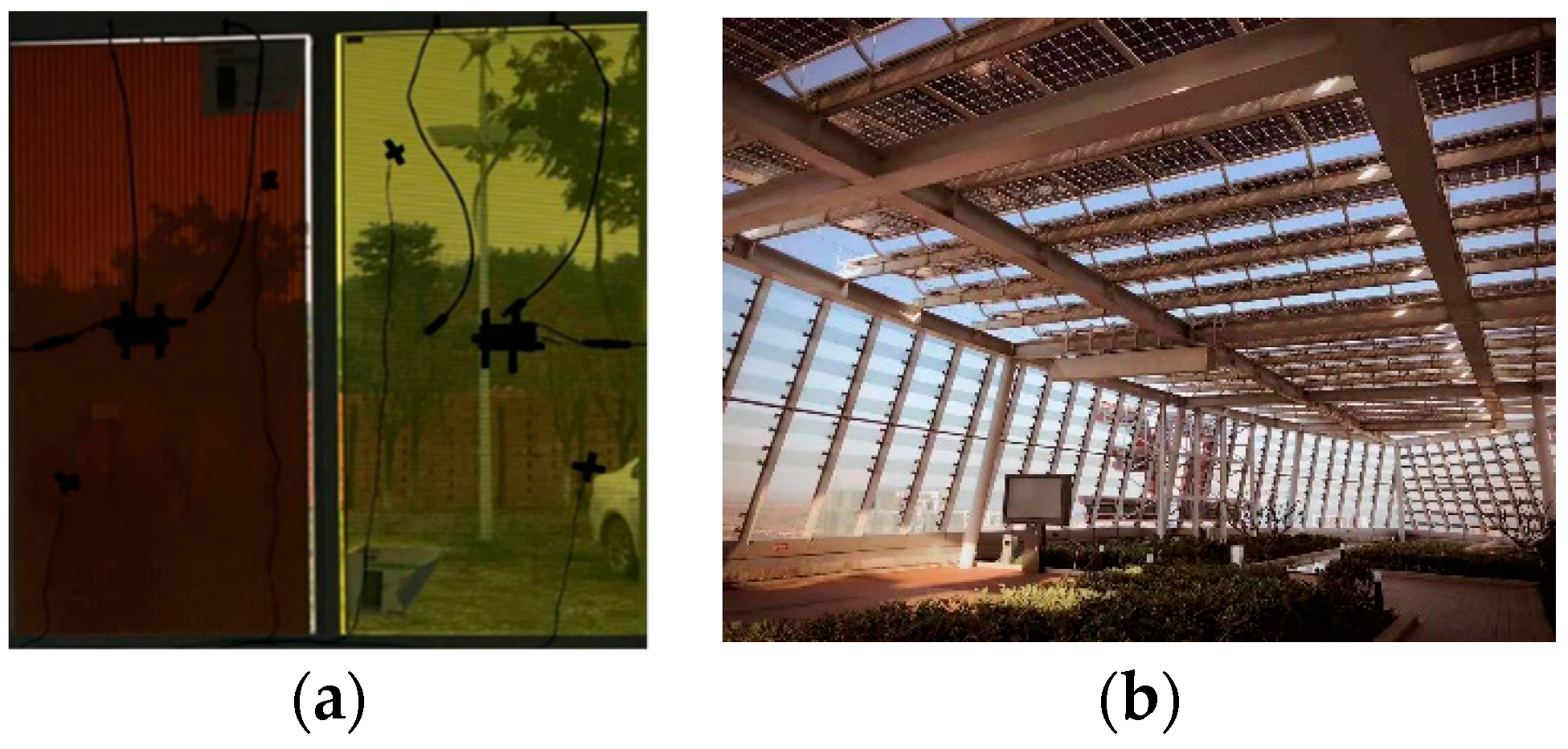
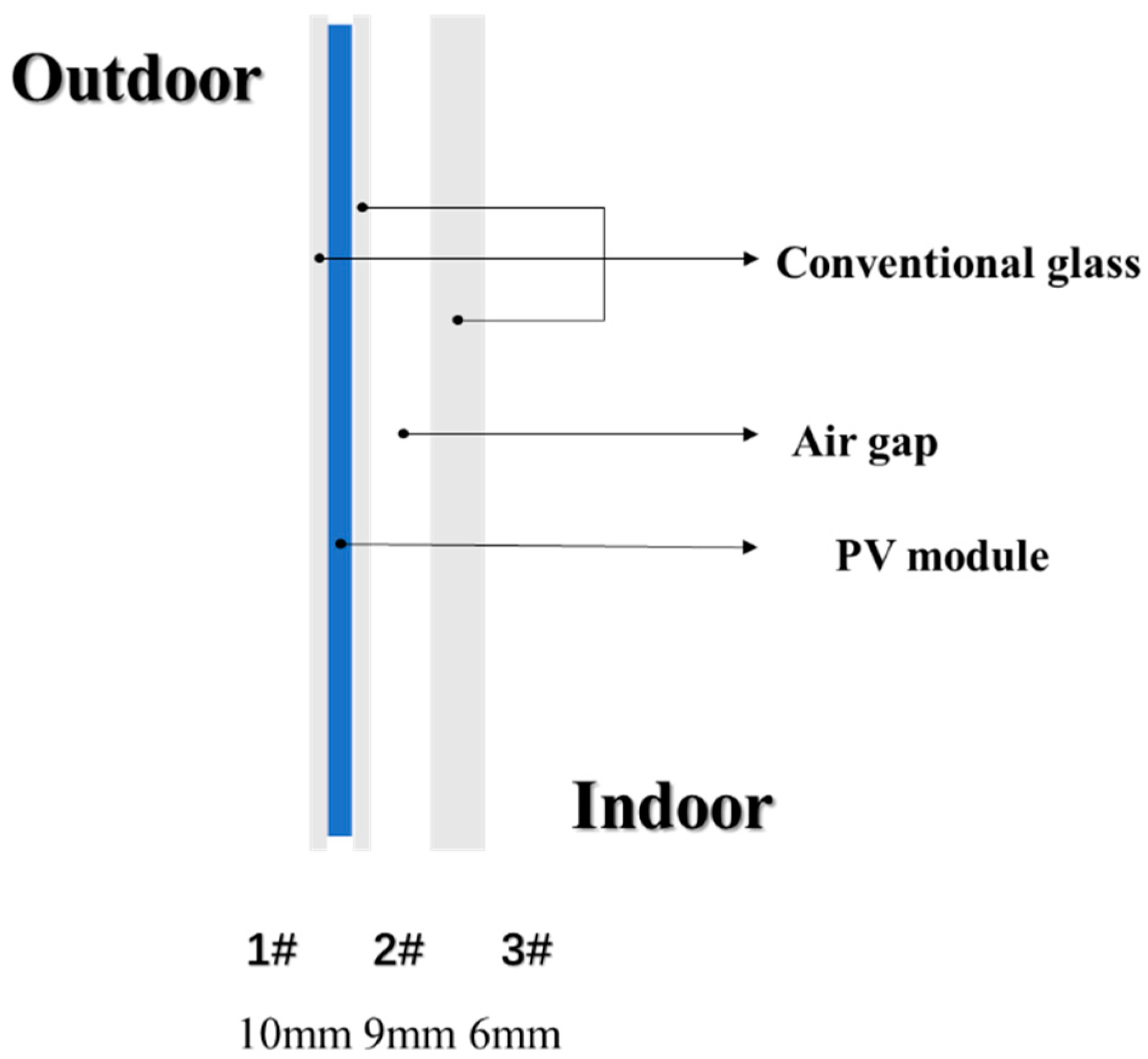
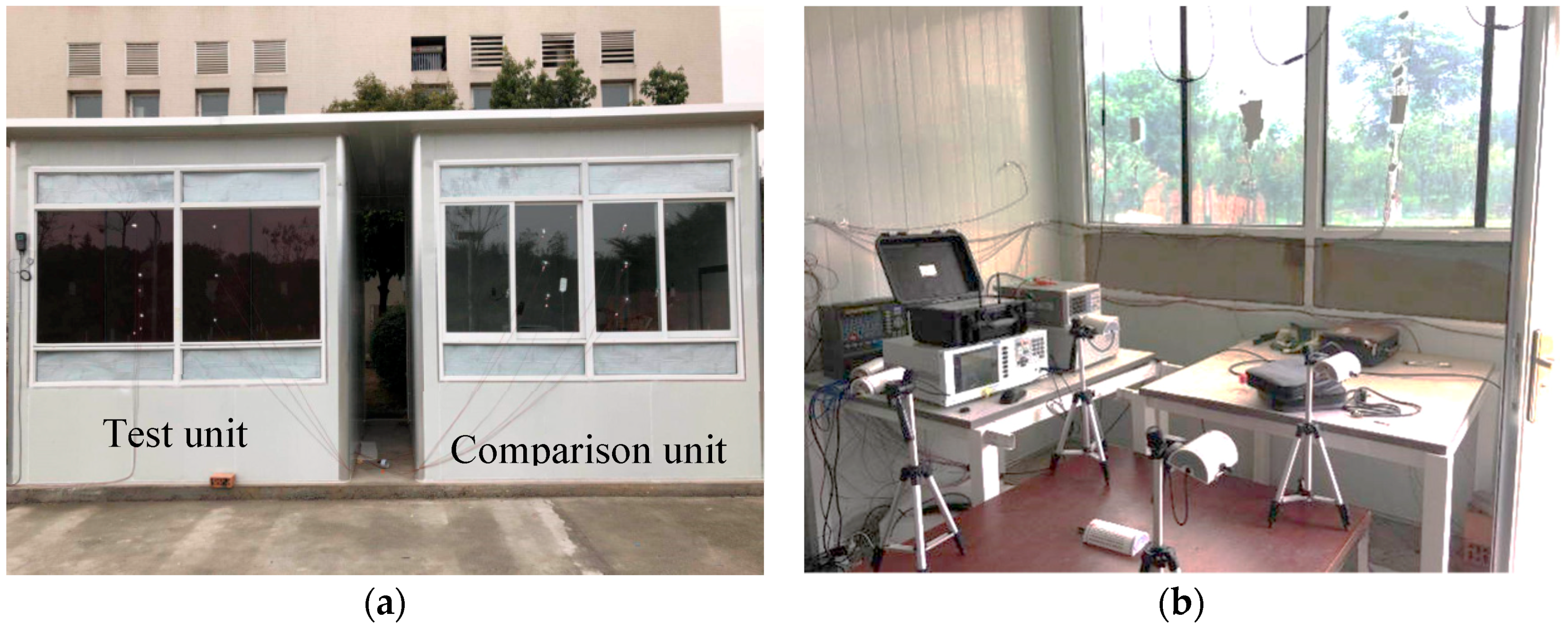


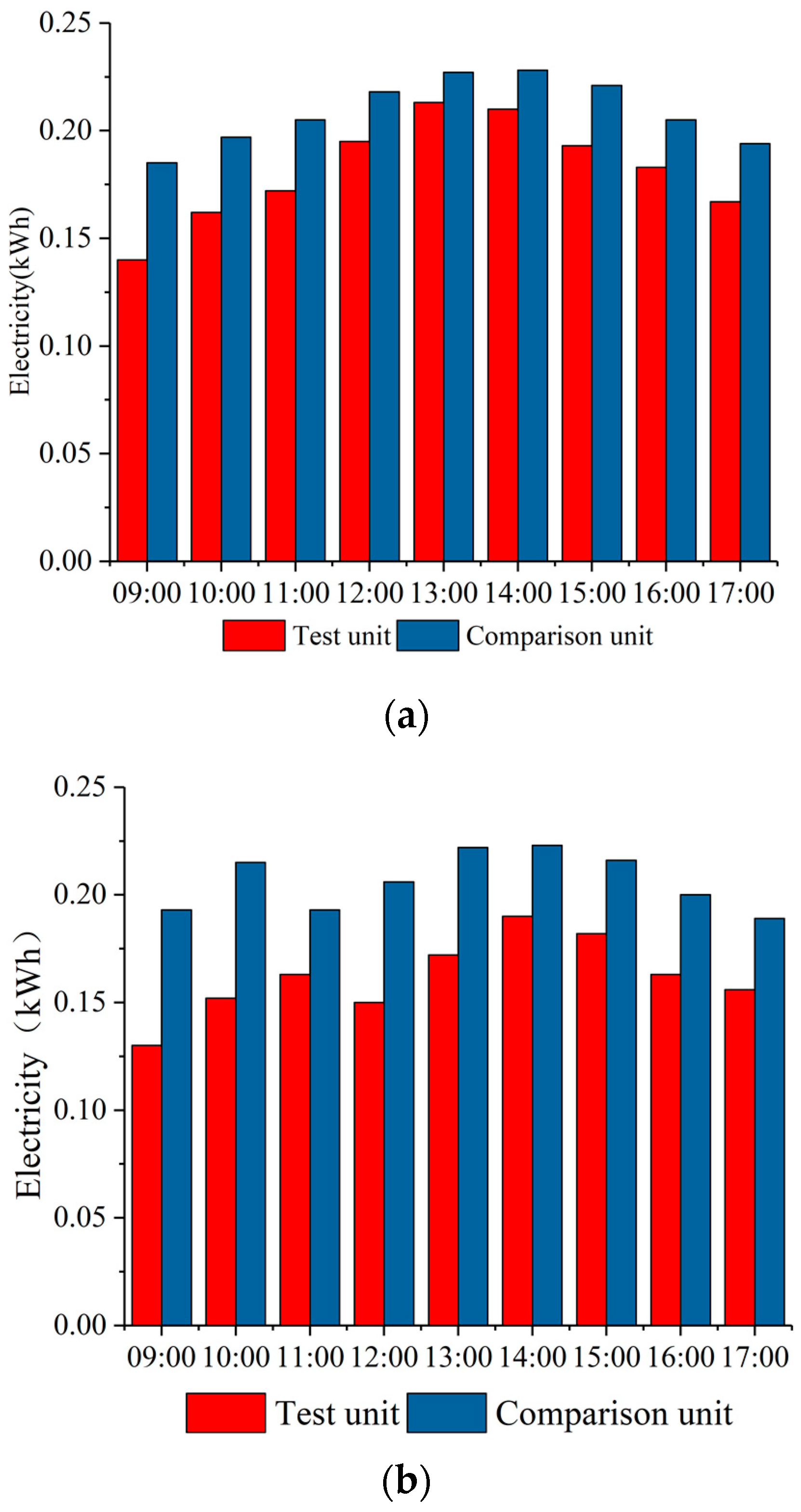

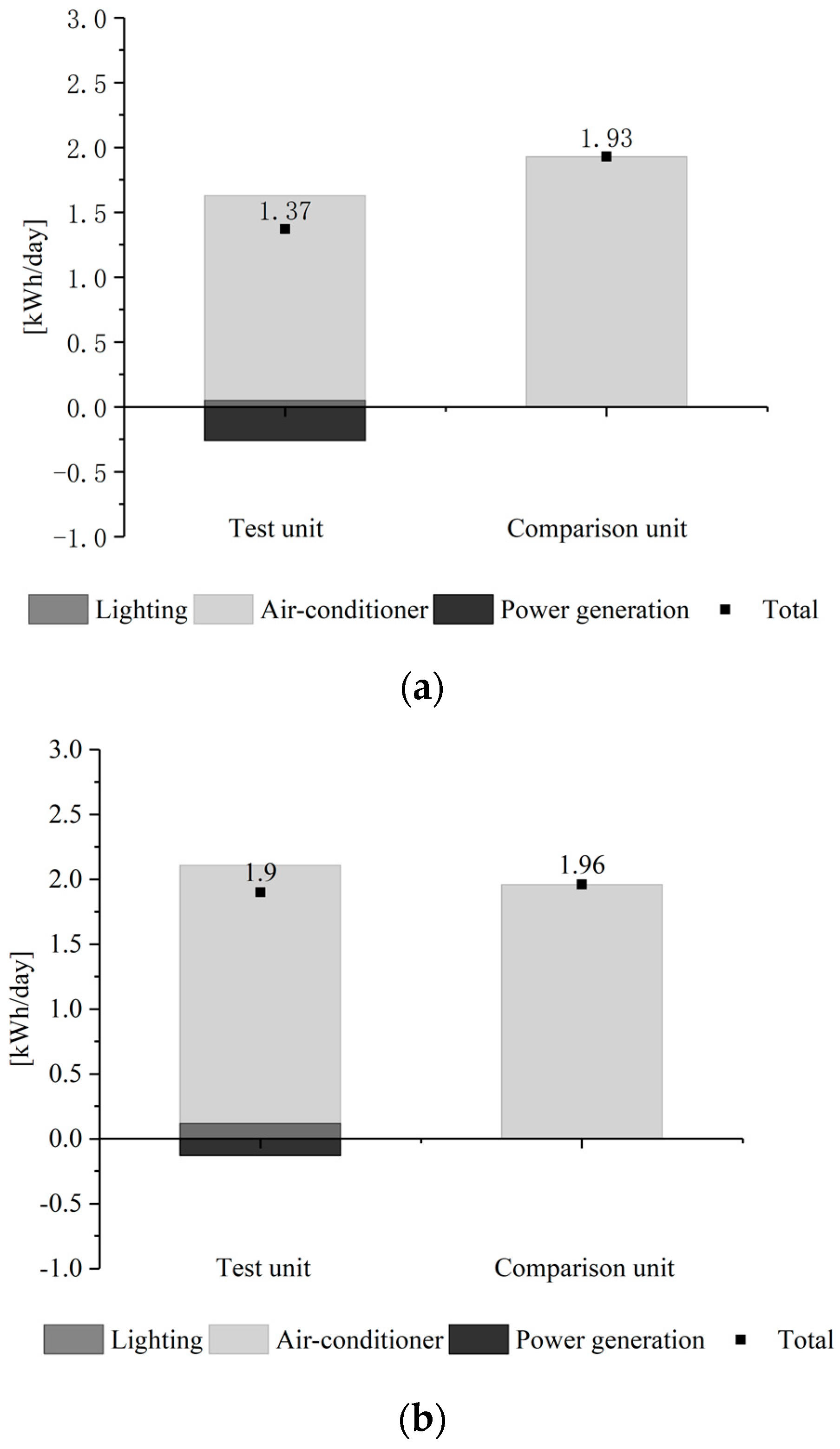


| a. Physical properties of STPV window | |
| Layer/Property | thickness (mm) |
| Glass-tempered | 6 |
| Air gap | 9 |
| Single STPV window | 10 |
| b. Physical properties of conventional window | |
| Layer/Property | thickness (mm) |
| Glass-tempered | 8 |
| Air gap | 9 |
| Glass-tempered | 8 |
| c. Electrical properties of STPV window | |
| PV module type | a-SiGe |
| Maximum power under STC (W) | 50 |
| Photoelectric conversion rate | 6.7% |
| d. Other properties of windows | |
| Dimension of each STPV window and conventional window | 1.24 m (L) × 0.64 m (W) |
| Visible transmittance of the STPV window | 20% |
| Weight density of the double-skin STPV window | 40 kg/m2 |
| Equipment | Manufacturer | Function and Model | Range/Sensitivity | Number |
|---|---|---|---|---|
| Outdoor multi-channel PV test equipment | Ceyear AV6595A | PV testing (three 500 W module and one 10 kW module) | 0 W–10 kW, 1% | 1 |
| Solar radiation test equipment | AV87110 | Testing the solar radiation upon the south façade | 0–1800 W/m2; ±3% | 1 |
| Weather station | J.t | Weather condition recorder | Temperature: ±0.5 °C, humidity: 0.1%, ±2%; atmospheric pressure: 1 mbar; wind rate: 0.1 m/s; wind direction: ±5% | 1 |
| Multi-channel data recorder | J.t | Data collector | The minimum resolutions are 1 μV and 0.1 °C | 1 |
| Thermocouples | J.t | Temperature test (T type thermocouple) | −20 °C–100 °C; 0.1 °C; ±0.5 °C | 24 |
| Light meter | J.t | - | 0–100,000 lux; 1 lux; ±4% | 8 |
| Electricity recorder | BULL | Record electricity consumption | 0–3000W, ±1% | 4 |
| Test unit | ||||
| Date | Weather | Maximum illuminance | Average illuminance | Total lighting electricity consumption |
| 21st June | Sunny | 1205 lx | 983 lx | 0 kWh |
| 22nd June | Cloudy to sunny | 1078 lx | 763 lx | 0.1 kWh |
| 23rd June | Cloudy | 419 lx | 207 lx | 0.3 kWh |
| Comparison unit | ||||
| Date | Weather | Maximum illuminance | Average illuminance | Total lighting electricity consumption |
| 21st June | Sunny | 3505 lx | 2683 lx | 0 kWh |
| 22nd June | Cloudy to sunny | 2178 lx | 1763 lx | 0 kWh |
| 23rd June | Cloudy | 2119 lx | 832 lx | 0 kWh |
| Difference from test and comparison unit | ||||
| Date | Weather | Maximum illuminance | Average illuminance | Total lighting electricity consumption |
| 21st June | Sunny | 34% | 36% | - |
| 22nd June | Cloudy to sunny | 49% | 43% | - |
| 23rd June | Cloudy | 19% | 24% | - |
| Locations | Climatic Zone | Global Solar Radiation (MJ/m2) | Average Temperature in Summer (°C) | Average Temperature in Winter (°C) |
|---|---|---|---|---|
| Chengdu/Capital of Sichuan | Hot Summer Cold Winter | 6.67 | 27.8 | 5 |
| Guiyang/Capital of Guizhou | Hot Summer Cold Winter | 10.72 | 23.2 | 4.6 |
| Lhasa/Capital of Tibet | Cold Zone | 21.92 | 15.5 | 1 |
| Kunming/Capital of Yunnan | Temperate | 18.91 | 20 | 10 |
© 2018 by the authors. Licensee MDPI, Basel, Switzerland. This article is an open access article distributed under the terms and conditions of the Creative Commons Attribution (CC BY) license (http://creativecommons.org/licenses/by/4.0/).
Share and Cite
Tian, H.; Zhang, W.; Xie, L.; Wu, Y.; Sun, Y.; Chen, M.; Wang, W.; Wu, X. Study on the Energy Saving Potential for Semi-Transparent PV Window in Southwest China. Energies 2018, 11, 3239. https://doi.org/10.3390/en11113239
Tian H, Zhang W, Xie L, Wu Y, Sun Y, Chen M, Wang W, Wu X. Study on the Energy Saving Potential for Semi-Transparent PV Window in Southwest China. Energies. 2018; 11(11):3239. https://doi.org/10.3390/en11113239
Chicago/Turabian StyleTian, Hao, Wei Zhang, Lingzhi Xie, Yupeng Wu, Yanyi Sun, Mo Chen, Wei Wang, and Xinwen Wu. 2018. "Study on the Energy Saving Potential for Semi-Transparent PV Window in Southwest China" Energies 11, no. 11: 3239. https://doi.org/10.3390/en11113239





